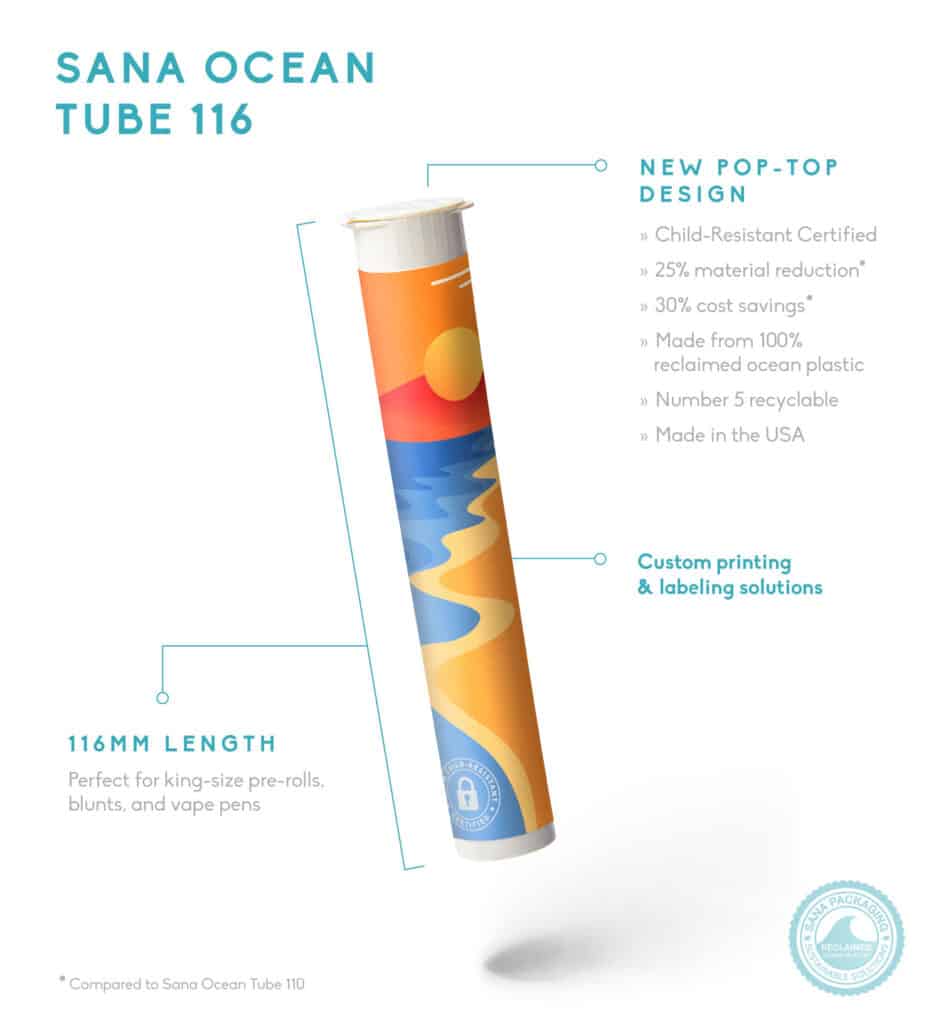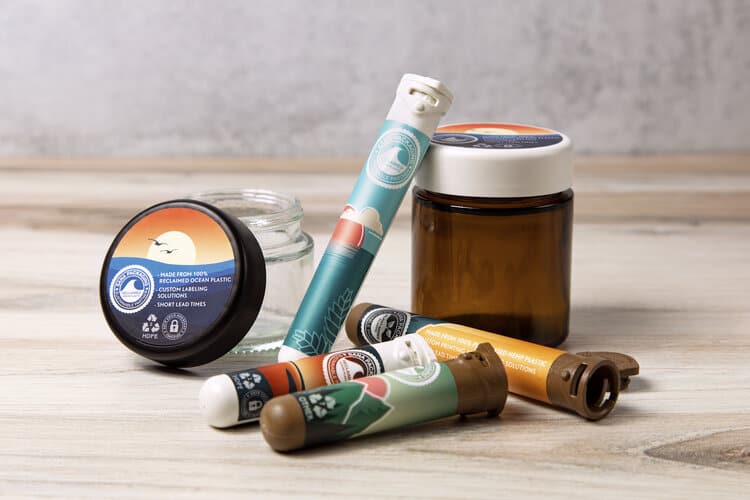For an industry that’s big on green, we have a dirty little secret. Single-use consumer packaged goods containers are responsible for a quarter of waste generated in the United States, most of the materials used for packaging are not recycled, and the cannabis industry is part of the problem. In fact, the US cannabis industry is expected to contribute one billion pieces of single-use plastic in 2020. Our increasing demand for packaging is generating waste that will most likely come to rest in a landfill. As an industry we need to address our growing dependency on single-use packaging and develop sustainable options.
The US cannabis industry is expected to contribute 1 billion pieces of single-use plastic in 2020.
Here’s the dilemma. Options for sustainable packaging are currently expensive and limited. Cannabis packaging needs to be child resistant and effectively maintain the product’s shelf life. It’s difficult to find sustainable materials that meet these demands. When they do, the packaging is always more expensive than unsustainable packaging and product variety is limited. Will cannabis consumers pay more for sustainable packaging?
Short answer: probably. A report released this year by the Boston Consulting Group says nearly three quarters of consumers polled would pay more for sustainable packaging. Among these respondents, nearly three quarters revealed they would tolerate a 10% cost increase to pay for sustainable packaging. Polling data released early this month says 79% of cannabis consumers are in favor of establishing environmental standards for cannabis products. It’s safe to assume cannabis consumers would accept paying more for sustainable packaging. But what are brands doing to make the change?
Royal Supply CEO Robert Kenny says, “Brands themselves are not developing sustainable packaging; they’re relying on other companies in the industry to push those efforts forward.” Kelly says brands are relying on suppliers like himself for sustainable packaging and they’re eager to know: “Who’s coming up with the next thing?”
The need for recyclable, compostable, and biodegradable plastic
Brands use plastic to package an assortment of cannabis products: flower drams, doob tubes, edible bags, concentrate lids, and vape components.
The appeal is clear. Plastic is cost-effective and versatile. It allows brands to easily develop attractive child resistant packaging that effectively maintains product integrity. It’s also easily recyclable. The big problem: only 9% of plastic bound for recycling is actually recycled. Most discarded plastic will degrade in a landfill over the next few centuries, and leftover micro-plastics will linger much longer.

Some packaging suppliers are dedicated to increasing the use of recycled content. Alpha Packaging and Sana Packaging offer containers produced with “ocean bound plastic.” This means that suppliers reclaim and recycle plastic discarded in a body of water or on land within fifty kilometers of a shoreline. This recycling method is an innovative attempt to reclaim plastic.
As the National Cannabis Industry Association recently noted in a report, “The recycling model has an important [sustainability] role to play in the short-term, but long-term the industry needs to create less single-use packaging in the first place.” Brand leaders who recognize this reality are considering sustainable packaging that doesn’t include virgin or recycled plastic. They have a number of options to choose from.
Elevate Packaging has designed compostable plant-based pouches. Sana Packaging has developed an array of plant-based plastic that’s partly manufactured with hemp and compostable in an industrial composting facility. Meanwhile, Dama Distributing claims their hemp-based plastic containers are home compostable in fourteen months.
Biodegradable plastic packaging is also an option. STO Responsible has developed packaging made with a natural enzyme that rapidly degrades plastic in a landfill. The enzyme encourages microorganisms living in the soil to eat the plastic. The only waste left is microplastics generated by the microorganisms eating the plastic, and the remaining microplastics will naturally break down over time.
Kenny from Royal Supply says recent developments in biodegradable plastic technology will drive down its cost and expand options. There’s noticeable excitement in his voice as he makes this prediction–widespread adoption of biodegradable plastics would end the scourge of petroleum-based plastics.
But we’re not quite there. All these options are expensive. Packaging suppliers say brands will need to pay at least three times as much for sustainable plastic packaging. In addition to its expense, the variety in sustainable packaging design is limited. Finding a sustainable match of your current packaging could be a challenge. This limitation could force a change in a brand’s packaging procedures and equipment. Kenny says, “You’re going to have to get creative with how you’re packaging your products.”
Sustainability grades: paper, glass, metal, and vaporizers
Plastic isn’t the only culprit. Brands use paper boxes as secondary packaging for edibles, concentrates, and vaporizers. The ability to add creative design elements to paper packaging gives brands an opportunity to maximize a product’s shelf appeal, but secondary packaging obviously also creates another level of waste.
Packaging suppliers like Contempo Specialty Packaging and Printed on Hemp offer hemp paper and other sustainable options, but the type of paper isn’t the only consideration. Brands also need to evaluate the sustainability of the ink and coating used in manufacturing of packaging, which can render paper unrecyclable. This consideration can lead to limitations when designing sustainable paper packaging.
Glass and metals like tin and steel are used to manufacture primary packaging for flower, edibles, concentrates and beverages. There’s a healthy recycling market for glass and metals and these materials will most likely avoid a landfill. An added benefit is their sealing and design capabilities. N2 Packaging Systems locks nitrogen into flower containers to extend shelf life. Tin Canna elegantly designs compact packaging for edible brands.
Disposable vape products are roundly known as the industry’s least sustainable product. Plastic, metal and glass are fused together to develop vape cartridges and they’re impossible to recycle in the US. Americans also can’t recycle the disposable batteries manufactured in single-use cartridges.
But the Canadian cannabis industry is driving innovation in vape recycling. Several Canadian vape companies recently announced a partnership with a recycling company to address vape waste. Emterra Group will collect and disassemble used vapes dropped in bins located at participating retailers. The metal, plastic and battery from the vapes will then be recycled.
Don’t get accused of greenwashing
Sustainability efforts can be effectively used in brand marketing if done right. But without tact, your brand runs the risk of incurring accusations of greenwashing, or making hollow claims about a brand’s sustainability. How can your brand avoid this label? It comes down to transparency and actually going the extra mile.
Michael Markarian is the CEO of Contempo Specialty Packaging and host of a podcast dedicated to sustainable cannabis packaging. The first season of The Sustainable Packaging Show encouraged brands to consider sustainable packaging offerings on the market. Season 2 of the podcast launched last month. This season will examine how packaging suppliers can provide accountability in their sustainability claims. Markarian says he’s interested in “starting a movement away from greenwashing in cannabis.”
Markarian believes a brand’s marketing should explain how the company is taking a holistic approach with their sustainability efforts. Is your brand focusing on sustainability in the parts of the business that aren’t consumer facing? Has your brand evaluated sustainability across the supply chain?
How can we improve?
Constantly changing labeling regulations increase the cost of packaging, and exorbitant 280E taxes further eat up budgets. Regulators need encouragement to amend onerous banking, taxing, and labeling regulations that prevent investment in sustainable packaging.
And Brands need encouragement to invest in sustainability. On some level, this falls to the consumer to hold brands accountable for meeting a level of sustainability that’s generally accepted in the industry. But it also calls for the brands that are leading the pack in sustainability to educate the consumer so that they’re willing to pay a premium for sustainable packaging. Ultimately, this is an exciting proposition. The cannabis industry is being created before our eyes and everyone involved has an opportunity to develop a sustainable industry that could be modeled elsewhere. We’re the future!






3 thoughts on “Cannabis packaging and the search for a sustainable solution”
Pingback: Can renewable packaging be affordable? Humidi.co thinks so. - MJ Brand Insights
Pingback: Cannabis Has a Packaging Problem - CannaBuff
Pingback: 10 cannabis brands with innovative packaging solutions - MJ Brand Insights